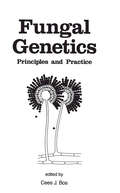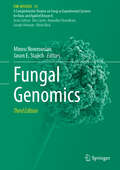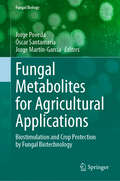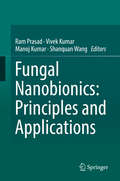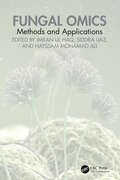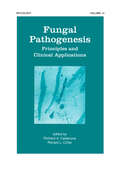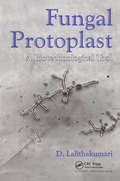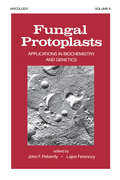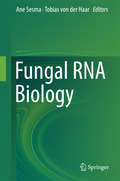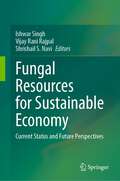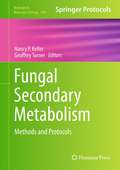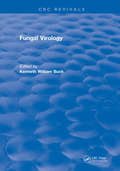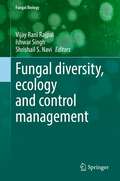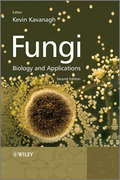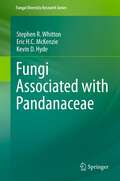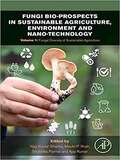- Table View
- List View
Fungal Genetics: Principles and Practice
by Cees J. BosThis is a concise guide to the combined use of classical and molecular methods for the genetic analysis and breeding of fungi. It presents basic concepts and experimental designs, and demonstrates the power of fungal genetics for applied research in biotechnology and phytopathology. Case studies of Saccharomyces cerevisiae, Candida albicans, Aspergillus niger, Neurospora crassa, Podospora anserina, Phytophthora infestans and others are included.
Fungal Genomics
by Burton H. Bluhm Jin-Rong XuHaving experienced unprecedented growth since the turn of the millennium, the dramatic expansion of resources and techniques in fungal genomics is poised to fundamentally redefine the study of fungal biology. In Fungal Genomics: Methods and Protocols, expert researchers explore the three most likely fronts upon which the field will advance: the sequencing of more and more fungal genomes, the mining of sequenced genomes for useful information, and most importantly, the use of genomics sequences to provide a foundation for powerful techniques to explain biological processes. Much of the book is dedicated to explaining established and emerging genomics-based technologies in filamentous fungi, including gene expression profiling techniques, techniques for fungal proteomics as well as various case studies that could be adapted to a wide range of fungi. Written in the highly successful Methods in Molecular BiologyTM series format, protocol chapters include brief introductions to their respective topics, lists of the necessary materials and reagents, step-by-step laboratory protocols, and key unpublished tips, potential pitfalls, common mistakes, and special considerations based on the unique experiences of the contributors. Authoritative and cutting-edge, Fungal Genomics: Methods and Protocols provides fungal biologists at any stage of their careers a user-friendly resource for fungal genomics, especially as readers branch out into unfamiliar but exciting new areas of study.
Fungal Genomics
by Minou NowrousianThe volume is divided into four sections, the first of which, Genome Sequences and Beyond, illustrates the impact of genome-based information and techniques on research ranging from model organisms like yeast to less-studied basal fungal lineages. Furthermore, it highlights novel types of analysis made possible by multi-genome comparisons as well as the impact of genomics on culture collections and vice versa. The second section, Cell and Developmental Biology, addresses questions that are important for fungal biology, e. g. the development of fungal fruiting bodies, and biology in general, e. g. chromatin organization and circadian rhythms. The third section, Genomics for Biotechnology, covers the search for plant biomass-converting enzymes in fungal genomes and work with industrially important fungi. The fourth section, focusing on Pathogenicity, offers chapters on the genomic analysis of plant and animal/human pathogens. It illustrates how genomics at all levels, from genome to metabolome, is used to study mechanisms of the interactions of fungi with other organisms.
Fungal Genomics (The Mycota #13)
by Minou Nowrousian Jason E. StajichThis fully revised 3rd edition of Fungal Genomics highlights the impact of genomics on the field of fungal biology in four sections: Part I Genome Sequences and Beyond: Examines the impact of genome-based information and techniques on research ranging from the discovery of giant transposons to the analysis of less-studied extremotolerant fungi as well as studies of three-dimensional chromatin organization in fungi. Part II Cell and Developmental Biology: Explores advances in high-throughput genetics/genomics and RNA editing in fungi, the role of codons in gene regulation, and the analysis of epigenetic regulation in early-diverging fungi. Part III Biotechnology: Covers the search for plant biomass-converting enzymes in fungal genomes and work with industrially important fungi. Part IV Interactions - Symbioses, Mutualisms, and Pathogens: Explains the genomic analysis of the emerging human pathogen Candida auris as well as genomic signatures in ectomycorrhizal fungi. This book is a must-read for anyone interested in the exciting field of fungal genomics.
Fungal Genomics: Methods and Protocols (Methods in Molecular Biology #1775)
by Ronald P. de Vries Adrian Tsang Igor V. GrigorievThis volume details protocols covering nearly all aspects of fungal genomics. New and updated chapters guide the reader through experimental genomics, biotechnologies, and the analysis and processing of data. Written in the highly successful Methods in Molecular Biology series format, chapters include introductions to their respective topics, lists of the necessary materials and reagents, step-by-step, readily reproducible laboratory protocols, and tips on troubleshooting and avoiding known pitfalls. Authoritative and practical, Fungal Genomics : Methods and Protocols, Second Edition aims to ensure successful results in the further study of this vital field.
Fungal Metabolites
by Kishan Gopal Ramawat Jean-Michel MérillonThis handbook compiles authoritative information about fungal metabolites and their chemistry and biotechnology. The first in the reference work series "Phytochemicals", and written by a team of international expert authors, this book provides reference information ranging from the description of fungal natural products, over their use e. g. as anticancer agents, to microbial synthesis, even spanning to the production of secondary metabolites on industrial scale. On the other hand it also describes global health issues related to aflatoxin production in foods and agriculture, including perspectives for detoxification. The handbook characterizes different compound classes derived from fungal secondary metabolites, like ergot alkaloids and aflatoxins. The discussion puts a special emphasis on how potentially useful compounds can be obtained and what applications they can find, on the one hand, and how potential dangers can be encountered on the other hand. The comprehensive chapters in this handbook will thus appeal to readers from diverse backgrounds in chemistry, biology, life sciences, and even medicine, who are working or planning to work with fungal (secondary) metabolites and their application. They provide the readers with rich sources of reference information on important topics in this field.
Fungal Metabolites for Agricultural Applications: Biostimulation and Crop Protection by Fungal Biotechnology (Fungal Biology)
by Jorge Poveda Óscar Santamaría Jorge Martín-GarcíaThis book delves into the fascinating world of fungal metabolites and their biotechnological potential for sustainable agriculture. Through this book, readers will learn about the production and characterization of metabolites by endophytic and rhizospheric fungi, including filamentous fungi like Trichoderma, Penicillium, and Aspergillus, as well as mycorrhizal fungi and yeasts. The chapters cover topics such as the promotion of plant growth, increased tolerance to abiotic stresses, and biological control through the application of fungal metabolites. Expert contributors provide an in-depth analysis of how these metabolites can be produced in bioreactors or applied directly as agricultural bioinoculants. Particular attention is given to the environmental and health benefits of using fungal metabolites in crop improvement. Researchers in the field of agricultural biotechnology, plant sciences, and environmental sustainability will find this book invaluable. It offers a comprehensive discussion from biological, chemical, and applied perspectives, making it a must-read for anyone interested in advancing sustainable agriculture practices.
Fungal Nanobionics: Principles and Applications
by Manoj Kumar Ram Prasad Vivek Kumar Shanquan WangFungal nanobionics has great prospects for developing new products with industrial, agriculture, medicine and consumer applications in a wide range of sectors. The fields of chemical engineering, agri-food, biochemical, pharmaceuticals, diagnostics and medical device development all employ fungal products, with fungal nanomaterials currently used in a wide range of applications, ranging from drug development to food industry and agricultural sector. The fungal agents emerge as an environmentally friendly, clean, non‐toxic agent for the biogenic metal nanoparticles and employs both intracellular and extracellular methods. The simplicity of scaling up and downstream processing and the presence of fungal mycelia affording an increased surface area provide key advantages. In addition, the larger spectrum of synthesized nanoparticle morphologies and the substantially faster biosynthesis rate in cell-free filtrate (due to the higher amount of proteins secreted in fungi) make this a particularly enticing route. Understanding the diversity of fungi in assorted ecosystems, as well as their interactions with other microorganisms, animals and plants, is essential to underpin real and innovative technological developments and the applications of metal nanoparticles in many disciplines including agriculture, catalysis, and biomedical biosensors. Importantly, biogenic fungal nanoparticles show significant synergistic characteristics when combined with antibiotics and fungicides to offer substantially greater resistance to microbial growth and applications in nanomedicine ranging from topical ointments and bandages for wound healing to coated stents.
Fungal Omics: Methods and Applications
by Imran Ul Haq Siddra Ijaz Hayssam Mohamad AliFungal Omics: Methods and Applications provides a comprehensive account of trends and developments in fungal “omics” approaches. It presents literature on various “omics” applications and includes information on plant taxonomy, genetics, epigenetics, and biotechnological and industrial applications. It begins with basic concepts, extending to complex and in-depth knowledge, and finally describing the fungal genome and all “omics” comprehensively.Key Features: Covers almost every aspect of fungal omics in a single source Features trends in phytomycology and fungal biology studies using modern molecular tools Contains information on improved methods in genetics, genomics, and metabolomics in different fungal species Highlights include integrative “omics” strategies as well as trends in phytomycology and fungal biology using modern molecular tools. With detailed information on improved methods in genetics, genomics, and metabolomics, Fungal Omics: Methods and Applications is an invaluable resource for scientists, researchers, and students in the evolving fields of fungal omics and life sciences.
Fungal Pathogenesis in Plants and Crops: Molecular Biology and Host Defense Mechanisms, Second Edition (Books in Soils, Plants, and the Environment)
by P. VidhyasekaranDramatic progress in molecular biology and genetic engineering has recently produced an unparalleled wealth of information on the mechanisms of plant and pathogen interactions at the cellular and molecular levels. Completely revised and expanded, Fungal Pathogenesis in Plants and Crops: Molecular Biology and Host Defense Mechanisms, Second Edition
Fungal Pathogenesis: Principles and Clinical Applications
by Richard CalderoneStresses molecular and biochemical studies of opportunistic and frank fungal pathogens!This book gives a comprehensive overview of human pathogenic fungi that offers a current and concise survey of virulence factors, host responses and recognition, treatment and diagnosis of infections, invasive enzymes, intracellular survival, morphogenesi
Fungal Plant Pathogens: Applied Techniques
by Paul Kirk David Smith David Cooke Jenny Tomlinson David Galsworthy Christopher Thornton Belinda Phillipson Michael Long Rachel Barker Matthew J Ryan Kinda Alraiss Victoria Barton Lucy Carson-Taylor Ashleigh Elliot Steve Hendry Anthony Kermode Aiga Ozolina Ana Pérez-Sierra Joan WebberThis substantially updated edition now in full colour provides key techniques used when working with fungal and fungal-like plant pathogens. As a practical manual it also deals with disease recognition, detection and identification of fungi, plus methods to characterise and curate fungi and handle them under quarantine and quality assurance systems. Furthermore, this new edition includes significant updates with respect to: - Greater awareness and concern internationally about plant health and biosecurity. - Molecular biology - next generation sequencing and in-field detection. - Improved opportunities for surveillance and detection in diverse substrates. - Changes in taxonomy and reference to current fungal plant pathogens. - New chapters on tree health, and public awareness, outreach and communications. Fungal Plant Pathogens: Applied Techniques, 2nd edition provides a valuable guide to investigating fungal plant diseases and interpreting laboratory findings for postgraduate and advanced undergraduate students, extension plant pathologists, consultants and advisers in agriculture, forestry and horticulture, and the food supply chain.
Fungal Protoplast: A Biotechnological Tool
by D LalithakumariBetter validation of indigenous domestic animal genetic resources is becoming more important with regard to the potential of livestock for poverty alleviation and income generation. To improve indigenous breeds for sustainable income and employment generation, the methods to be employed are the same as developed in systematic breeding programs, be it for cross-breeding or selective breeding within a specific breed. This book systematically introduces the reader to the breed improvement theory and illustrates the theory with practical examples and case studies. The book is addressed to animal science teachers, to undergraduate and postgraduate students as well as to decision makers in the state and central livestock departments.
Fungal Protoplasts: Applications in Biochemistry and Genetics
by John F. PeberdyUntil now, information on fungal protoplasts has been scattered throughout various sources. With authoritative reviews of protoplast isolation and applications in fungal biology research, Fungal Protoplasts: Applications in Biochemistry and Genetics is the first volume devoted to a major area in experimental mycology-fungal protoplasts.Written by 18 pioneering experts, this unmatched, illustrated reference presents well-established knowledge of protoplast research as well as newer ideas and methods. The book encompasses advances in protoplast isolation techniques and methodology, uses of protoplasts in physiological, biochemical, and genetic studies, and developments in protoplast fusion that form the basis for transformation and gene cloning experiments, including applications in industrial biotechnology. This fact-filled book also features end-of-chapter bibliographies for further research.
Fungal RNA Biology
by Ane Sesma Tobias HaarThis book presents an overview of the RNA networks controlling gene expression in fungi highlighting the remaining questions and future challenges in this area. It covers several aspects of the RNA-mediated mechanisms that regulate gene expression in model yeasts and filamentous fungi, organisms of great importance for industry, medicine and agriculture. It is estimated that there are more than one million fungal species on the Earth. Despite their diversity (saprophytic, parasitic and mutualistic), fungi share common features distinctive from plants and animals and have been grouped taxonomically as an independent eukaryotic kingdom. In this book, 15 chapters written by experts in their fields cover the RNA-dependent processes that take place in a fungal cell ranging from formation of coding and non-coding RNAs to mRNA translation, ribosomal RNA biogenesis, gene silencing, RNA editing and epigenetic regulation.
Fungal Resources for Sustainable Economy: Current Status and Future Perspectives
by Vijay Rani Rajpal Ishwar Singh Shrishail S. NaviThis edited book provides a comprehensive account of the new developments in various facets of fungal biology related to the impact and application of fungi on the sustainable economy. The book consists of 24 chapters distributed under five sections written by active researchers and academicians from India and abroad. The five sections of the book are- 1. Fungi in Sustainable Economy, 2. Fungal Resources: Current and Potential Industrial Applications, 3. Fungal Resources: Current and Potential Agricultural Applications, 4. Fungi and their Secondary metabolites: Implications and 5. Fungi: Burden to health and Indoor Environment.The book explores the utility of fungi as food, enzymes, organic compounds, nutraceuticals, pharmaceuticals and agricultural productivity promoter. It also highlights the negative fungal impacts on food production, health and environment. The book is useful to postgraduate students studying mycology, plant pathology, crop protection, agricultural sciences, and plant sciences. In addition, scientists involved in biological and agricultural research, crop management, and various industries that manufacture or utilize fungal products on a small to large scale shall also find the book helpful.
Fungal Secondary Metabolism
by Geoffrey Turner Nancy P. KellerFilamentous fungi have long been known for their ability to produce an enormous range of unusual chemical compounds known as secondary metabolites, many of which have potentially useful antibiotic or pharmacological properties. Recent focus on fungal genomics coupled with advances in detection and molecular manipulation techniques has galvanized a revitalization of this field. Fungal Secondary Metabolism: Methods and Protocols is aimed at providing the key methodologies currently in use and necessary for accessing and exploiting the natural product information provided by the genomes of this large and varied kingdom. Written by active researchers in the field, the chapters deal with all the steps necessary, from optimization of fungal culture conditions for metabolite production, through rapid genome sequencing and bioinformatics, and genetic manipulations for functional analysis, to detection and testing of metabolites. In addition, chapters on basic science address approaches to the genetic regulation, protein biochemistry, and cellular localization of the biosynthetic pathways. Written in the highly successful Methods in Molecular BiologyTM series format, chapters include introductions to their respective topics, lists of the necessary materials and reagents, step-by-step, readily reproducible laboratory protocols, and tips on troubleshooting and avoiding known pitfalls. Practical and hands-on, Fungal Secondary Metabolism: Methods and Protocols encourages new investigators to enter the field and expands upon the expertise and range of skills of those already researching fungal natural products.
Fungal Siderophores: From Mineral―Microbe Interactions to Anti-Pathogenicity (Fungal Biology)
by Kalyani Dhusia Kalpana Raja Pramod RamtekeIn the past few decades, it has been realized through research that fungal siderophores epitomize the uptake of iron as well as other essential elements like zinc, magnesium, copper, nickel and arsenic. Understanding the chemical structures of different fungal siderophores and the membrane receptors involved in uptake of mineral ions has opened new areas for research. In this edited volume, recent research is presented on fungal siderophores in one comprehensive volume to provide researchers a strong base for future research. Siderophores are the low molecular weight, high affinity iron-chelating compounds produced by bacteria and fungi. They are responsible for transporting iron across the cell membrane. Fungi produce a range of hydroxamate siderophores involved in the uptake of essential elements in almost all microorganisms and plants. In recent years, siderophores have been used in molecular imaging applications to visualize and understand cellular functions, which thus provide an opportunity to identify new drug targets. Therefore, knowledge of fungal siderophores has become vital in current research. Siderophores have received much attention in recent years because of their potential roles and applications in various research areas. Their significance in these applications is because siderophores have the ability to bind a variety of metals in addition to iron, and they have a wide range of chemical structures and specific properties. For instance, siderophores function as biocontrols, biosensors, and bioremediation and chelation agents, in addition to their important role in weathering soil minerals and enhancing plant growth. This book focuses on siderophores with the following significant points. It discusses leading, state-of-the-art research in all possible areas on fungal siderophores. The contributors are well-known and recognized authorities in the field of fungal siderophores. It discusses a projection of practical applications of fungal siderophores in various domains. This is the first book exclusively on fungal siderophores. In this comprehensive, edited volume, we show leading research on fungal siderophores and provide the most recent knowledge of researchers' work on siderophores. This book presents in-depth knowledge on siderophores to researchers working in areas of health sciences, microbiology, plant sciences, biotechnology, and bioinformatics.
Fungal Virology
by Kenneth William BuckSince their discovery 25 years ago, fungal viruses have created a new field of study in mycology and virology. The purpose of this book is not only to serve as a useful reference work but also to provide reviews of the important advances which have taken place since the last books on fungal viruses appeared. An introductory chapter gives a critical overview of fungal virology in the context of virology as a whole and of recent developments in molecular biology. Specialist chapters follow, all written by experts who are currently active in fungal virus research and cover ongoing research areas.
Fungal Waste Biomass Management for Energy, Environment and Value-Added Products (Fungal Biology)
by Dan Bahadur Pal Swarn Lata BansalBioconversion of waste is a natural process aiding in the recovery of resources and biotechnology-facilitated natural recycling processes. Biotechnological treatments to food processing wastes found in large quantities can produce useful end products, such as microbial biomass protein, while wastes are also purified during the process. Fungi as microorganism and as fungal biomass have been used for many applications such as enzyme production for biomedical, biorefinery, and other industries. Additionally, environmental pollution is a crucial problem for the entire world, and it is growing continuously. Continuous growth of pollution is resulting harmful changes like global warming and pollution of air, water, and soil. These changes are directly associated with various activities like uncontrolled agricultural practices, deforestation, urbanization, accumulation of huge amounts of agricultural and food waste, improper dumping of naturally occurred waste and forest residues, etc. Therefore, proper utilization of these wastes may be a better solution for this problem. Fungal-based biomass materials are good sources of carbohydrates, oil & fats, cellulosic content, and other useful chemical components which can be converted into value-added products for production of clean energy, bioenergy, bio-adsorbents, and useful chemicals. This book provides information, processes, and ideas for the conversion of waste into useful and consumable enzymes through biological approaches. Within the last few years, researchers have found that food and agricultural waste biomass have the potential to produce value-added products. Technological information for the production of nutraceuticals and organic acids from the agro-waste are also covered in this book.
Fungal diversity, ecology and control management (Fungal Biology)
by Vijay Rani Rajpal Ishwar Singh Shrishail S. NaviThis edited volume provides comprehensive and latest information on the fungal biodiversity in its morphological characters, bioactive molecules, pathogenicity and virulence, and its impacts on crop production and sustainable management of agricultural productivity towards resolving global food security issues. The increasing number of infectious fungal diseases are regarded as threats to agricultural productivity and global food security. The efforts done by scientists to inventories the fungal diversity and identification of fungal species contributing as pathogens towards many plant and human diseases have been compiled in the present volume. The identification of the potential fungal pathogens is a prerequisite for an effective disease control management program. Also important is to understand the complex interactions between the host-pathogen and the environment. The book dwells on insights on the aforementioned aspects. The book also includes articles on ecological significance of fungi and fungal antagonists used as biocontrol agents on other pathogens. This compilation is useful to scientists working in similar areas as well as to undergraduate and graduate students keen on getting updated information on the subject. Scientists involved in agricultural research, crop management, and industries that manufacture agrochemicals may also find it useful read.
Fungi
by Kevin KavanaghFungi: Biology and Applications, Second Edition provides a comprehensive treatment of fungi, covering biochemistry, genetics and the medical and economic significance of these organisms at introductory level. With no prior knowledge of the subject assumed, the opening chapters offer a broad overview of the basics of fungal biology, in particular the physiology and genetics of fungi and also a new chapter on the application of genomics to fungi. Later chapters move on to include more detailed coverage of topics such as antibiotic and chemical commodities from fungi, new chapters on biotechnological use of fungal enzymes and fungal proteomics, and fungal diseases of humans, antifungal agents for use in human therapy and fungal pathogens of plants.
Fungi Associated with Pandanaceae
by Kevin D. Hyde Stephen R. Whitton Eric H.C. McKenzieThe tropical plant family Pandanaceae comprises three genera, Freycinetia, Pandanus and Sararanga. One-hundred and fourteen genera and 226 species of fungi were found on dead leaves of Pandanaceae collected in Australia, Brunei Darussalam, Fiji, Hawaii, Hong Kong, Malaysia, Mauritius, Nepal, New Zealand, Niue, Philippines, Seychelles, Vanuatu and Vietnam. Taxonomic issues within each fungus genus are discussed and reference made to preceding work. All species are written up with bibliographic details, relevant measurements of the current specimens, known habitat and distribution, collection details, and a discussion on taxonomic conclusions. New taxa (4 genera, 35 species) are fully described and illustrated, each with a plate showing relevant macro- and microscopic details. Keys and/or synoptic tables are provided to all species in 28 genera. In addition, details on almost 700 species of fungi described and recorded worldwide from the Pandanaceae are listed.
Fungi Bio-prospects in Sustainable Agriculture, Environment and Nanotechnology: Volume 1: Fungal Diversity of Sustainable Agriculture
by Vijay Kumar Sharma Ajay Kumar Maulin P. Shah Shobhika ParmarFungi bio-prospects in sustainable agriculture, environment and nanotechnology is a three-volume series that has been designed to explore the huge potential of the many diverse applications of fungi to human life. The series unveils the latest developments and scientific advances in the study of the biodiversity of fungi, extremophilic fungi, and fungal secondary metabolites and enzymes, while also presenting cutting-edge molecular tools used to study fungi. Readers will learn all about the recent progress and future potential applications of fungi in agriculture, environmental remediation, industry, food safety, medicine, and nanotechnology. <P><P> Volume 1 will cover the biodiversity of fungi and the associated biopotential applications. This volume offers insights into both basic and advanced biotechnological applications in human welfare and sustainable agriculture. The chapters shed light on the different roles of fungi as a bio-fertilizer, a bio-control agent, and a component of microbial inoculants. They also focus on the various applications of fungi in bio-fuel production, nano-technology, and in the management of abiotic stresses such as drought, salinity, and metal toxicity.
Fungi Bioactive Metabolites: Integration of Pharmaceutical Applications
by Sanjai Saxena Sunil Kumar Deshmukh Jacqueline Aparecida TakahashiThis book presents the exploration and exploitation of various bioactive metabolites obtained from fungi isolated from diverse habitats for pharmaceutical applications. Various fungal sources have been brought under one umbrella ranging from endophytes, marine fungi, endolichenic fungi to fungi existing in the extremophilic conditions like desert and Antarctica and Artic environment. The book tries to cover maximally the range of the pharmaceutical applications wherein these bioactive agents from fungi have been exploited or are in the clinical pipelines and primarily include antibacterial, antifungal, antibiofilm, anticancer, antioxidant, autoimmunological, anti-inflammatory, and anti-thrombotic diseases. The book further emphasizes on the novel strategies to screen or enhance secondary metabolite production. Some other topics includes peptides, nonpeptides drugs, pigments, and enhancement of production of Echinocandin and Kojic acid. The role of bioinformatics in drug discovery and biotransformations have also been discussed. This book is going to be a comprehensive treatise and a valuable source for mycologists, biotechnologists, microbiologists, biotechnologists, and undertaking research in pharmaceutical sector as well as academia in setting up their research aspirations for using fungi in the process of drug discovery and development.
